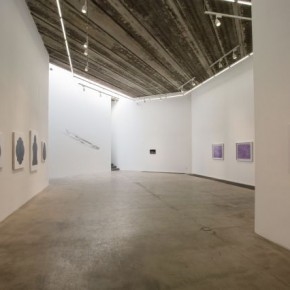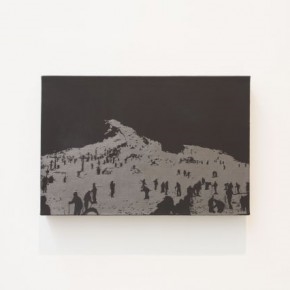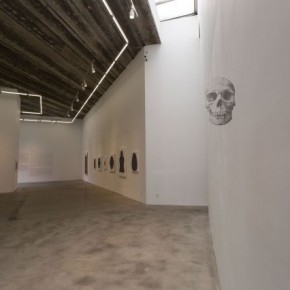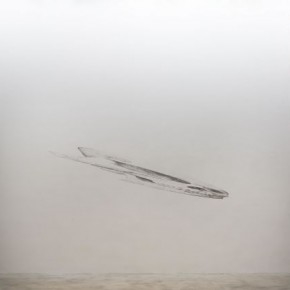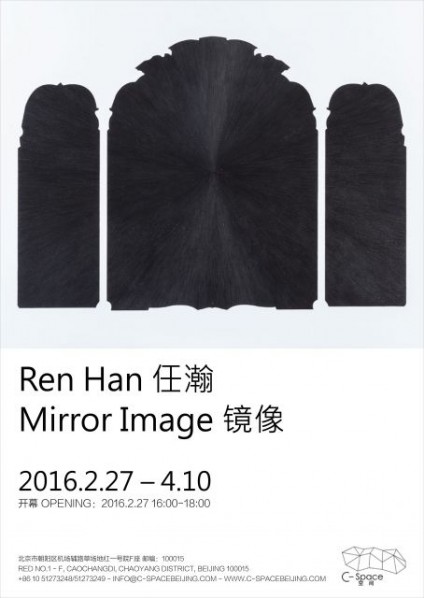
It was through observing his mother who worked as an accountant that Ren Han first encountered a common but delicate material as a child – carbon paper, which is commonly used for making multiple copies simultaneously of an original document when using a typewriter or a ballpoint pen. He found the repetitive and mundane use of this material, as well as the simplicity of the material itself fascinating. In his first exhibition at C-Space – Emulating Nature, which consisted of an installation of a small white cube space surrounded by black painted walls that were semi-destroyed by the artist with an axe that tied his Snow Mountain, Waterscape and Mirror series together – graphite was the primary medium in these works. In an interview for the exhibition, he mentioned that pencil’s uncomplicated and direct quality were what he found intriguing, and this fascination with straightforward tools and materials has continued to play a crucial part in his artistic practice today. In his latest works depicting scenes of disasters and Greek mythological figures, he uses the pencil to “sculpt” on the non-coated side of the carbon paper in a dotting manner, chiseling ink on the opposite, pigment-coated side. The harder the impact of the markings and the denser these dots are on the back side, the lighter the colour would appear on the front of the image. This dotting technique embodies elements of Seurat and Signac’s Pointillism, but without the use of colours and the employment of specific styles of brushwork, in fact, Ren’s approach is closer to the tattooing technique of Dotwork, where contours, light and shadow are created entirely out of dots of the same size but with varying distance in between. This repetitive technique is labour-intensive but also meditative, a quality that is constant in his images.
In the recent Disaster Landscape series, each work consists of nine pieces of engraved carbon papers as a collage. The differences between Untitled (Avalanche #1) and Untitled (Avalanche #2) from the this series might seem subtle, though as a matter of fact, the chosen viewpoint and the methods in which these images were sculpted are both different: Untitled (Avalanche #1) was entirely manually completed, depicting a slightly angled perspective of an avalanche; while the pencil was fixed on a moving jigsaw as a tool for Untitled (Avalanche #2), depicting the front of an avalanche. The methods employed in creating these two images: one with a softer and more time-consuming but also more controllable technique, and the other in a blunter manner with the aid of a machine – each correlating with its own content, respectively of a more distant viewpoint and a more immediate angle of an imminent danger. This slight change in perspective has a rather prominent effect on the way the image is perceived, and that is the shift between objectivity and subjectivity.
Repetition is a recurring element in Ren’s practice. In his Mirror series (2010~), the consumption of graphite and the record of bodily gestures through the markings of lines are emphasis in these works. Some of the recent Mirror works are of a collage of shapes, rather than a single shape taken from thesmaller baroque mirrors as portrayed in the majority of the works in the series. These combinations of shapes are composed in symmetry, whereby reinforcing the notion of mirroring in the image itself. While the viewer continues to be drawn to the center of these images where all the lines are converged, with Mirror #30 in particular, the largest piece in the series thus far that resembles the structure of stained glass windows in churches, we are required to keep a certain distance in order to observe it. Through the dense and directional lines in these Mirror works, as spectators we are guided into a state of meditation through the repeated act of looking, seeing and reflecting. Repetition is a characteristic of appropriation, which also plays a crucial role in Ren’s working methods. The visual content in his works is based on photos or fraction of photos taken from image search engines. This use of found images is not simply out of convenience, but a determined process stemmed from the artist’s interest in the energy embodied in ready-mades. He believes that energy evolves through the process of design, manufacture and repeated usage of these objects, and in this case, digital images of existing objects and places. Thus, Ren Han sees himself playing a role in this process in borrowing these images and recontextualizing them through means of copying and interpretation. Repetition is closely related to labour. In relation to his site-specific works such as Soft Impact (2013) and Precise Impact (2015), where the artist’s body is involved in seemingly simple but consuming tasks – hitting a painted black circle on the wall in an abandoned building with gravels; chiseling a perfect annulus on three perpendicular walls that could only been seen in its intended form in a specific position – labour does not only entail physical distress but also involves the discipline of control and precision.
There is also a common thread in the subject matters these works deal with, and that is the image of the sublime. By the artist’s own account, light is the most important element in his works. While light is a symbol of the divine, it is in Ren’s intentions to establish a “bridge” between worldliness and the divine through his graphite-forged mirror planes. This is also an underlying motive in his Snow Mountain, Waterscape and the most recent Disaster Landscapeseries. Edmund Burke speaks of the sublime in connection to experiences of awe, terror and danger in Philosophical Inquiry Into the Origins Of Our Ideas of the Sublime and the Beautiful (1757), and that nature is the most sublime object, capable of generating the strongest sensations in its beholders. This Romantic conception of the sublime has evidently continued to influence Ren Han as an artist and this notion of passion caused by the sublime, which “is that state of the soul, in which all its motions are suspended, with some degree of horror” (Burke), is further enforced in The Falling Men – the artist’s interpretation of Goltzius’ The Four Disgracers (1588), where the common bond between these fallers is that each one had tried to enter the realm of the gods and was subsequently punished for his arrogance. Ren took all four plates of Goltzius’ original engravings – Tantalus, Icarus, Phaeton and Ixion, and present both the sculpted copy of carbon paper and the printed copy on white paper as a set of work that is part of a complete series of four. While it is evident that each of these works consists of a mirrored copy and an original image, resonating with the mirroring of self and other, as well as heaven, hell and earth, it might not be as noticeable that the four seemingly varied poses depicted in the free-falling figures are in fact more or less the same pose viewed from different angles. Each of the fallers has one leg bent down and the other raised, one arm raised and the other lowered. While Phaeton and Icarus fall in light in Goltzius’ engravings, they appear in the “positive” printed copies of Ren’s interpretation, thus as Ixion and Tantalus tumble through darkness, they are depicted in the “negative” sculpted copies.
The duality that the mirror image presents, does not only denote the co-eternal binary oppositions of left and right, or self and other, but also the philosophical relationships of mind and matter, mind and body, as well as man and nature. As Michael Allen Gillespie writes in Nihilism Before Nietzsche, “man stands between nature and the divine, and is pulled by powerful forces in opposite directions.” To Ren Han, he stands between these dualities, and attempts in constructing a pathway connecting the two. In the history of human’s attempt in reaching spiritual enlightenment through means of physical distress and exhaustion including sensory deprivation and the mortification of the flesh, they do so to cease conscious thoughts. In Ren Han’s practice of disciplining control and balance, his introspective efforts seem to take on similar effects that are also reflected in his works, and through his mirror images, it is not the reflection of ourselves that we see, but a state of mind that we are induced into, in order to reflect on our own consciousness.
About the exhibition
Date: Feb 27, 2016 - Apr 10, 2016
Opening: Feb 27, 2016, Saturday
Venue: C-Space
Courtesy of the artist and C-Space.




